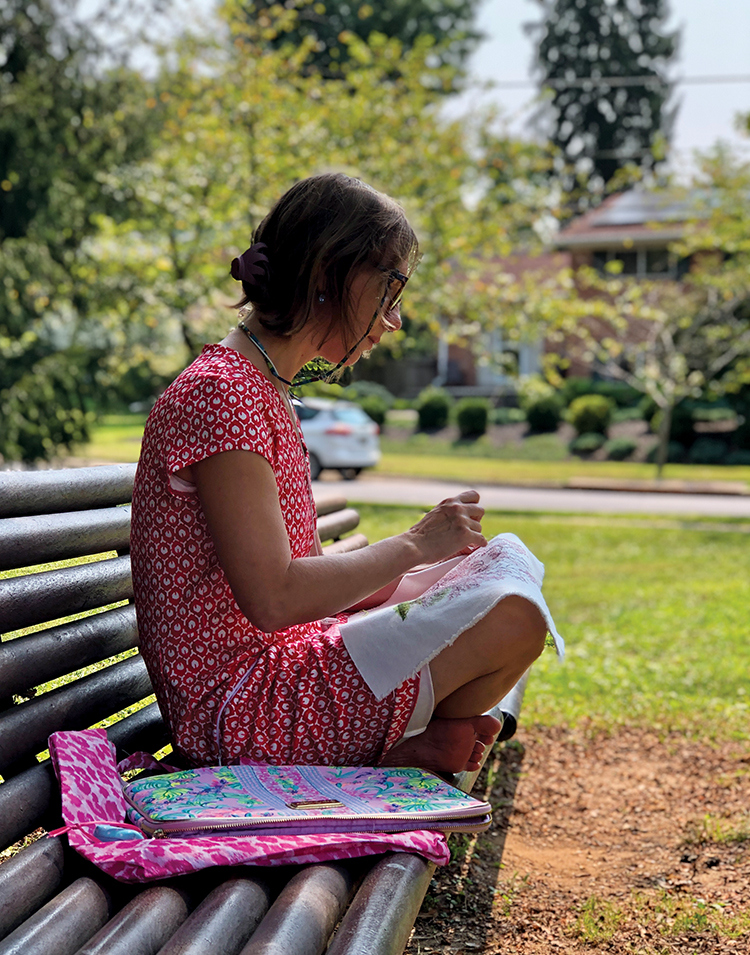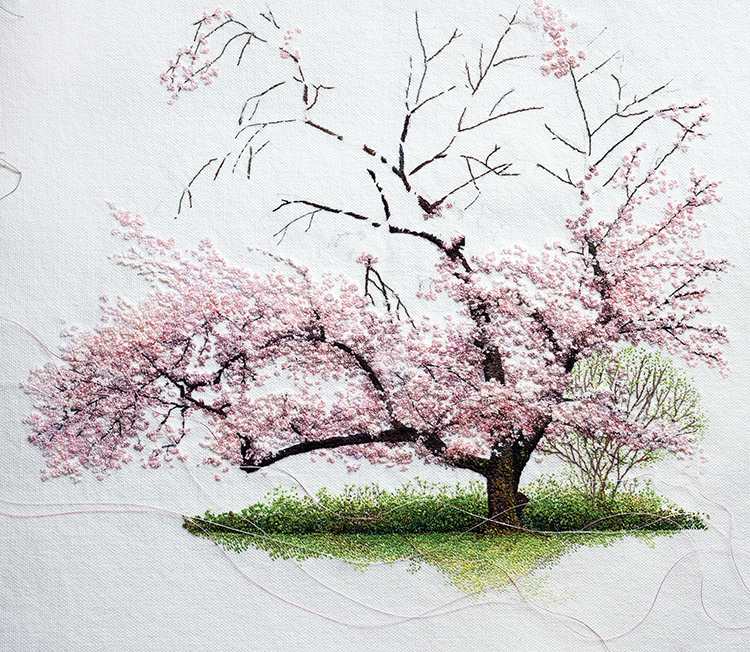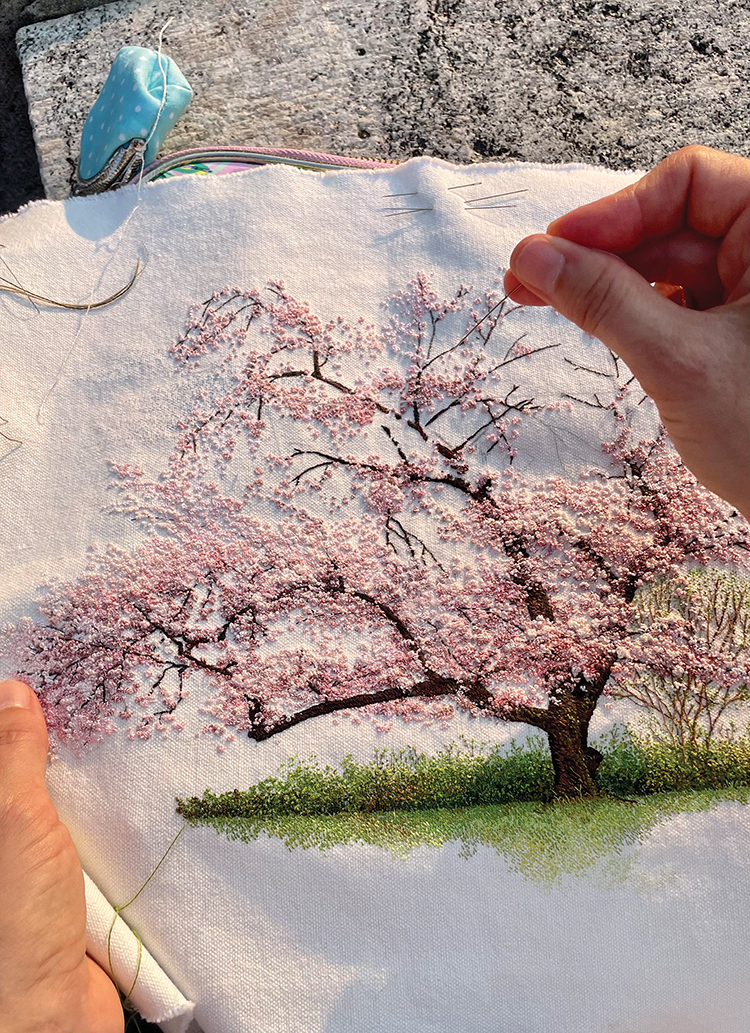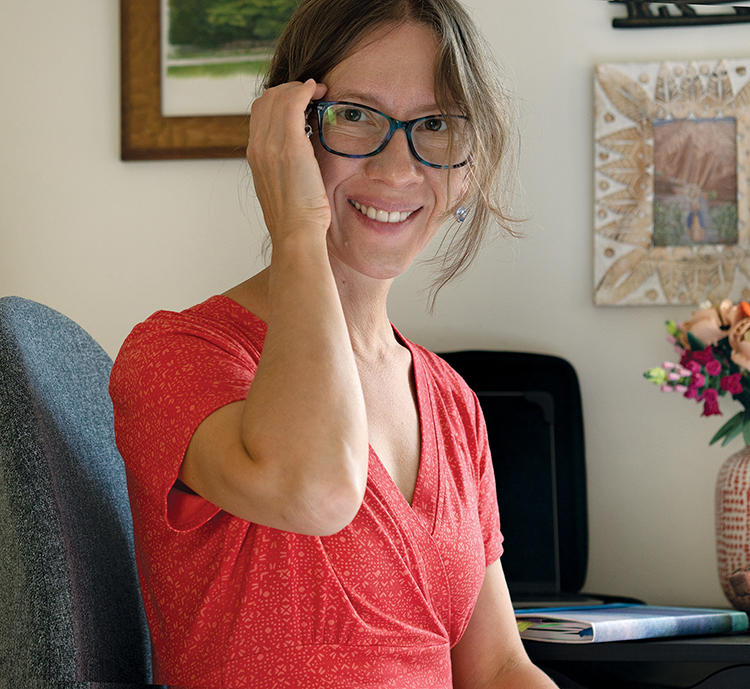
My embroidery story originates in Russia, a year before I moved to America. I was decorating my new apartment and was looking for suitable embroidery on the internet to make beautiful cushions. I didn’t want to do complicated cross-stitching and was hoping to find something pre-made with cross-stitched pictures. But between the price and the quality, nothing appealed to me.
I have always been able to draw and worked for some time as a designer and illustrator, and I thought I could easily embroider what I wanted right away. In reality, it took two years before I was able to embroider a picture that I really liked. I started by trying to make a design for cross-stitching based on my photo. But it turned out to be too difficult for me; besides, I realized that the stitches would have to be counted in the process, and everything related to mathematical accuracy isn’t for me.
I started to embroider flowers using different stitches — this is a type of decorative embroidery. I suppose I could have gone much further in this area, but I liked the French knot so much that I decided to limit myself to it and a couple of the most common stitches: straight and chain stitches. This is a quite limited set of stitches for a variety of decorative embroidery, but it was enough to start creating my own style.
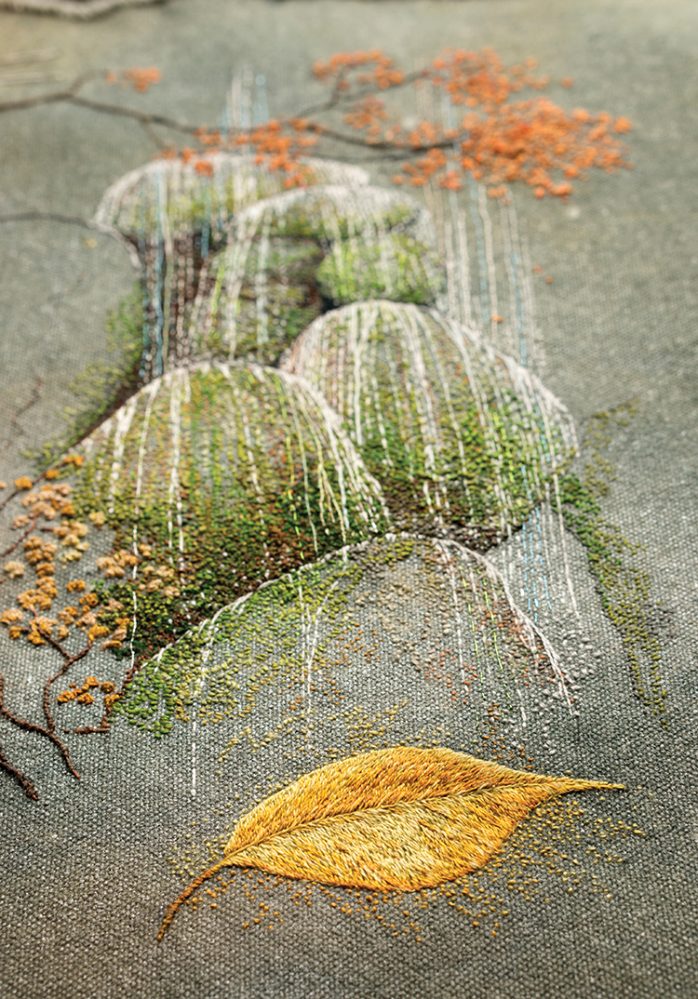
Around the same time, I became more interested in ancient and modern Asian art (from Japan, Korea, China): painting, prints, literature, manga and so on, and I really liked how ancient Asian artists painted landscapes. This is completely different from European painting because the painting was formed at a time when European culture hadn’t yet influenced Asian art. And some techniques in my embroidery were invented thanks to old Asian paintings. For example, I usually don’t make clear borders to the embroidery and don’t cover everything with stitches from edge to edge; and the canvas is also the space of the painting, which doesn’t have to be completely hidden under the stitches.
My first embroideries were designed to be cushions, which I did, and they are still in my bedroom. Back then, I felt disappointed to spend so much effort and just get cute cushions with a cute pattern. In addition, they would be difficult to sell because a lot of time and effort has been spent, and therefore the price for one cushion comes out as if Ralph Lauren sewed it with his own hands. So, I began to embroider pictures that can be hung on the wall anywhere, and you can admire them without fear of crumpling them.
At the beginning of my creative career, I repeated techniques that others do, mainly embroidering with a smooth surface. But I really wanted to achieve the effect in the paintings of Asian artists, and at first, I began to reduce the length of the stitches, use the surface less and cease embroidery with woolen threads and fabrics where the interweaving of threads isn’t too dense. I discovered that a lot depends on the thickness of the thread and a needle and began to use beaded thin needles. Then I caught sight of a canvas for artists in a hobby store, so the perfect fabric was found.
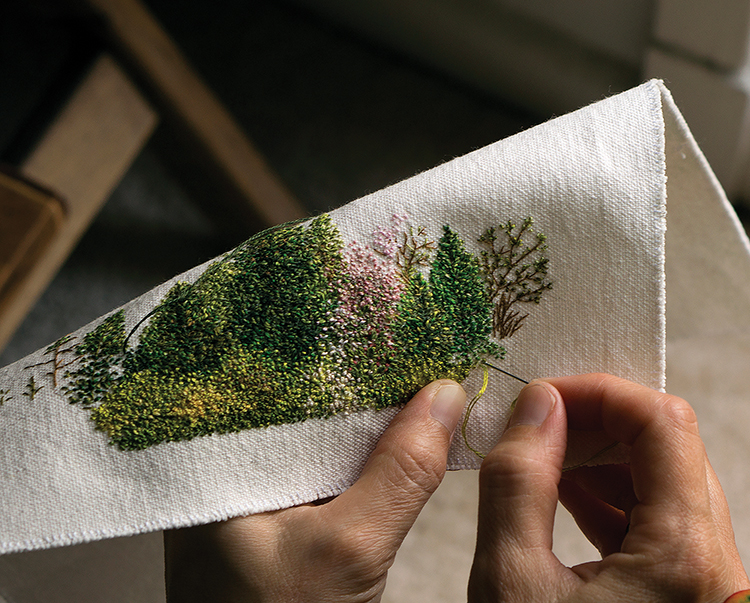
Each of my discoveries wasn’t because I was trying to come up with something new but because I needed to achieve a certain goal, and I actively started looking for them. After starting to embroider waterfalls, I began to use various decorative threads, as they made the image of water livelier. When I needed to show very thin branches, I found that the finest thread for weaving beads fits perfectly.
One of my last discoveries is threads for machine embroidery. This is a real find: They are very thin and give a light, shiny effect and allow me to make the smallest knots or thin branches; an image with their help can be made very detailed.
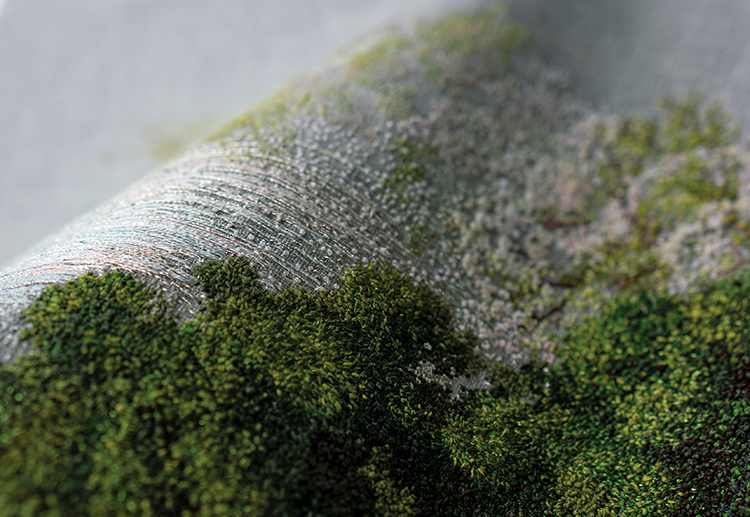
So, when the first and subsequent steps are successful, the result seems satisfactory, and there is a feeling that: Here it is, a high level has been achieved. I have encountered this before as an illustrator and understood that you just need to wait, and after some time, you will be able to see the shortcomings of the picture. And so, it happens. Then you start to reach higher levels, and so on all the time.
“Even if our dreams don’t come true, we’ll never forget how we dreamed about them.”
— A former editor of Russian Elle
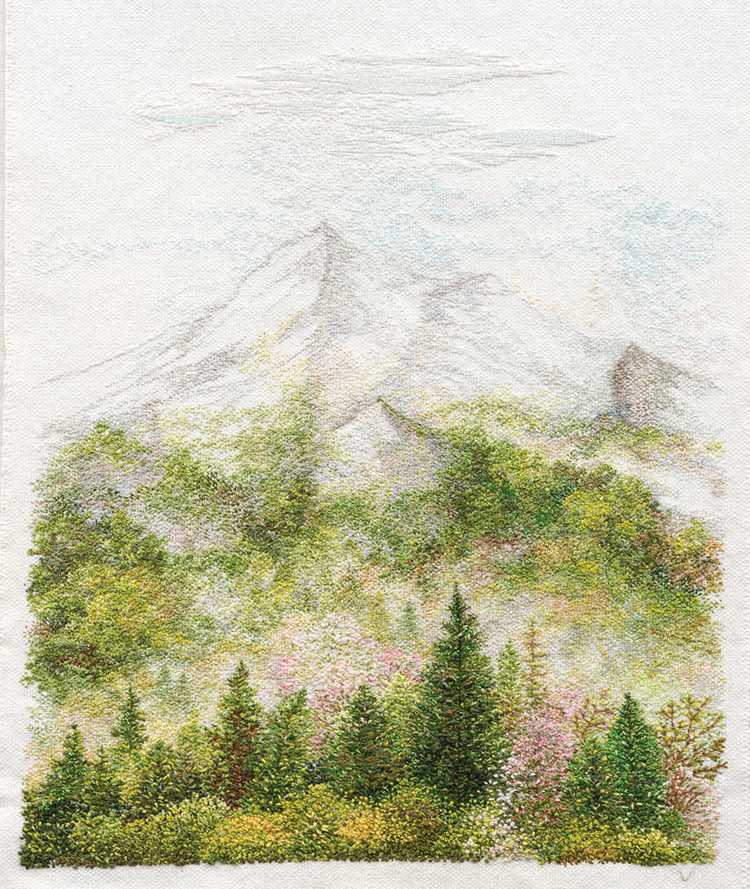
I never had any disappointments as I developed as an embroiderer, but there were and still are regrets that I can’t show everything I want with embroidery. With the help of a smooth surface, it would be more realistic; but although my embroidery style gives me some opportunities that I couldn’t achieve in other techniques, at the same time, it limits other possibilities. It makes me look for new ways to show what I want without changing my style.
I’m not afraid that one day I won’t know where to move on to or what subjects to embroider; I believe I haven’t achieved half of what I want. Today it seems to me impossible to lose inspiration; it is much more likely that I won’t have time to do everything I want because I need to spend time on other things. I need to learn how to sell my work. I have always considered myself only a hired worker, and now I must learn how to be an individual entrepreneur.
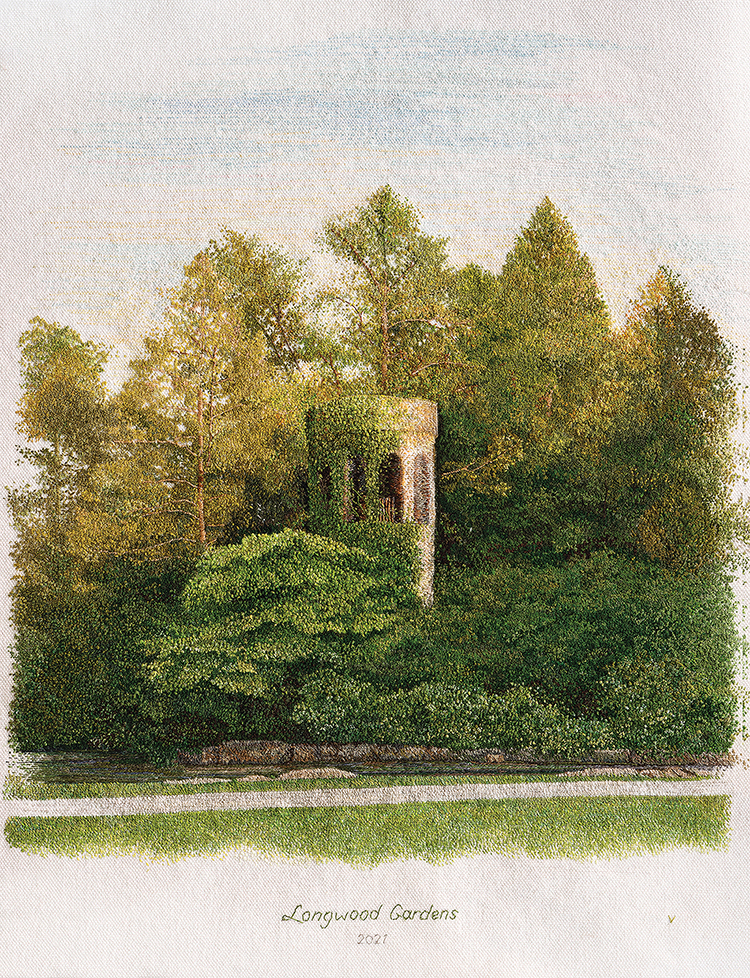
But my goal isn’t only to become a successful artist: I want to show people with my embroidery that inspiration can be found not only among the gorgeous views of mountains, lakes or forests but also in a backyard or looking at a lawn near a gas station along the highway. Some of my pictures show what surrounds me in everyday life.
I often embroider the places where I live, and these are the most ordinary urban places — of which there are thousands all over America. Like many people, I like to admire the ocean, mountains and forests; but I don’t have to go somewhere to get inspiration. It’s enough to walk close to home. I appreciate urban greenery no less than the greenery of wild nature because it was the reason, thanks to ordinary urban lawns, I began to embroider my first landscape.
Process For Creating
Canvas for artists and linen are my favorite types of fabric. I never use hoops or frames during the working process, just because it’s not my cup of tea.
Before starting work, I soak a fabric — this gives it shrinkage and makes it less elastic. After that, I bleach or dye it if I need colored background.
I draw a sketch, but it isn’t a detailed drawing because I want to leave opportunities to change something in the embroidery process if I need to. My working process is like a journey that allows route changes. I use a few types of well-known stitches: straight stitches, French knots and chain stitches. Also, sometimes I make stitches in a special way that was invented by me. Stitches of different thicknesses and heights create the effect of the depth of space, and the thinner the thread and needle, the more opportunities there are to show this effect.
I start to embroider the picture from the middle of the fabric and from the darkest places. Embroidery from the middle gradually spreads in all directions. This way the fabric stretches less, even after soaking. For linen, I use transparent hairspray. It helps to fix the fabric so that it doesn’t stretch, doesn’t spoil threads and is easily washed off.
When my work is finished, I soak an embroidery in warm water with a small amount of soap, then rinse, dry, and iron it from the inside out.
And finally, I celebrate the finishing of work with a latte and sweets!
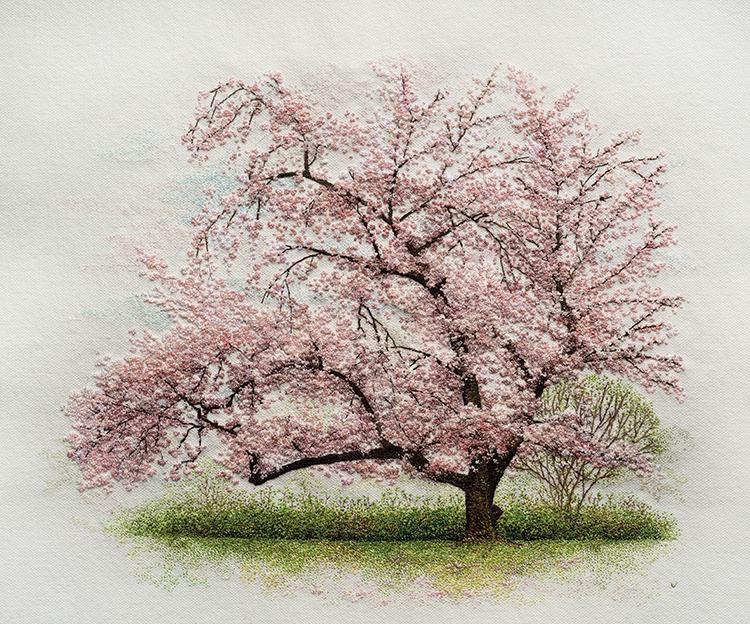
“After all, the cherry blossom blooms every year, but does anyone find it the less lovely for that?”
— Sei Shōnagon, Japanese poetess and writer

My embroidery story originates in Russia, a year before I moved to America. I was decorating my new apartment and was looking for suitable embroidery on the internet to make beautiful cushions. I didn’t want to do complicated cross-stitching and was hoping to find something pre-made with cross-stitched pictures. But between the price and the quality, nothing appealed to me.
I have always been able to draw and worked for some time as a designer and illustrator, and I thought I could easily embroider what I wanted right away. In reality, it took two years before I was able to embroider a picture that I really liked. I started by trying to make a design for cross-stitching based on my photo. But it turned out to be too difficult for me; besides, I realized that the stitches would have to be counted in the process, and everything related to mathematical accuracy isn’t for me.
I started to embroider flowers using different stitches — this is a type of decorative embroidery. I suppose I could have gone much further in this area, but I liked the French knot so much that I decided to limit myself to it and a couple of the most common stitches: straight and chain stitches. This is a quite limited set of stitches for a variety of decorative embroidery, but it was enough to start creating my own style.

Around the same time, I became more interested in ancient and modern Asian art (from Japan, Korea, China): painting, prints, literature, manga and so on, and I really liked how ancient Asian artists painted landscapes. This is completely different from European painting because the painting was formed at a time when European culture hadn’t yet influenced Asian art. And some techniques in my embroidery were invented thanks to old Asian paintings. For example, I usually don’t make clear borders to the embroidery and don’t cover everything with stitches from edge to edge; and the canvas is also the space of the painting, which doesn’t have to be completely hidden under the stitches.
My first embroideries were designed to be cushions, which I did, and they are still in my bedroom. Back then, I felt disappointed to spend so much effort and just get cute cushions with a cute pattern. In addition, they would be difficult to sell because a lot of time and effort has been spent, and therefore the price for one cushion comes out as if Ralph Lauren sewed it with his own hands. So, I began to embroider pictures that can be hung on the wall anywhere, and you can admire them without fear of crumpling them.
At the beginning of my creative career, I repeated techniques that others do, mainly embroidering with a smooth surface. But I really wanted to achieve the effect in the paintings of Asian artists, and at first, I began to reduce the length of the stitches, use the surface less and cease embroidery with woolen threads and fabrics where the interweaving of threads isn’t too dense. I discovered that a lot depends on the thickness of the thread and a needle and began to use beaded thin needles. Then I caught sight of a canvas for artists in a hobby store, so the perfect fabric was found.

Each of my discoveries wasn’t because I was trying to come up with something new but because I needed to achieve a certain goal, and I actively started looking for them. After starting to embroider waterfalls, I began to use various decorative threads, as they made the image of water livelier. When I needed to show very thin branches, I found that the finest thread for weaving beads fits perfectly.
One of my last discoveries is threads for machine embroidery. This is a real find: They are very thin and give a light, shiny effect and allow me to make the smallest knots or thin branches; an image with their help can be made very detailed.

So, when the first and subsequent steps are successful, the result seems satisfactory, and there is a feeling that: Here it is, a high level has been achieved. I have encountered this before as an illustrator and understood that you just need to wait, and after some time, you will be able to see the shortcomings of the picture. And so, it happens. Then you start to reach higher levels, and so on all the time.
“Even if our dreams don’t come true, we’ll never forget how we dreamed about them.”
— A former editor of Russian Elle

I never had any disappointments as I developed as an embroiderer, but there were and still are regrets that I can’t show everything I want with embroidery. With the help of a smooth surface, it would be more realistic; but although my embroidery style gives me some opportunities that I couldn’t achieve in other techniques, at the same time, it limits other possibilities. It makes me look for new ways to show what I want without changing my style.
I’m not afraid that one day I won’t know where to move on to or what subjects to embroider; I believe I haven’t achieved half of what I want. Today it seems to me impossible to lose inspiration; it is much more likely that I won’t have time to do everything I want because I need to spend time on other things. I need to learn how to sell my work. I have always considered myself only a hired worker, and now I must learn how to be an individual entrepreneur.

But my goal isn’t only to become a successful artist: I want to show people with my embroidery that inspiration can be found not only among the gorgeous views of mountains, lakes or forests but also in a backyard or looking at a lawn near a gas station along the highway. Some of my pictures show what surrounds me in everyday life.
I often embroider the places where I live, and these are the most ordinary urban places — of which there are thousands all over America. Like many people, I like to admire the ocean, mountains and forests; but I don’t have to go somewhere to get inspiration. It’s enough to walk close to home. I appreciate urban greenery no less than the greenery of wild nature because it was the reason, thanks to ordinary urban lawns, I began to embroider my first landscape.
Process For Creating
Canvas for artists and linen are my favorite types of fabric. I never use hoops or frames during the working process, just because it’s not my cup of tea.
Before starting work, I soak a fabric — this gives it shrinkage and makes it less elastic. After that, I bleach or dye it if I need colored background.
I draw a sketch, but it isn’t a detailed drawing because I want to leave opportunities to change something in the embroidery process if I need to. My working process is like a journey that allows route changes. I use a few types of well-known stitches: straight stitches, French knots and chain stitches. Also, sometimes I make stitches in a special way that was invented by me. Stitches of different thicknesses and heights create the effect of the depth of space, and the thinner the thread and needle, the more opportunities there are to show this effect.
I start to embroider the picture from the middle of the fabric and from the darkest places. Embroidery from the middle gradually spreads in all directions. This way the fabric stretches less, even after soaking. For linen, I use transparent hairspray. It helps to fix the fabric so that it doesn’t stretch, doesn’t spoil threads and is easily washed off.
When my work is finished, I soak an embroidery in warm water with a small amount of soap, then rinse, dry, and iron it from the inside out.
And finally, I celebrate the finishing of work with a latte and sweets!

“After all, the cherry blossom blooms every year, but does anyone find it the less lovely for that?”
— Sei Shōnagon, Japanese poetess and writer








